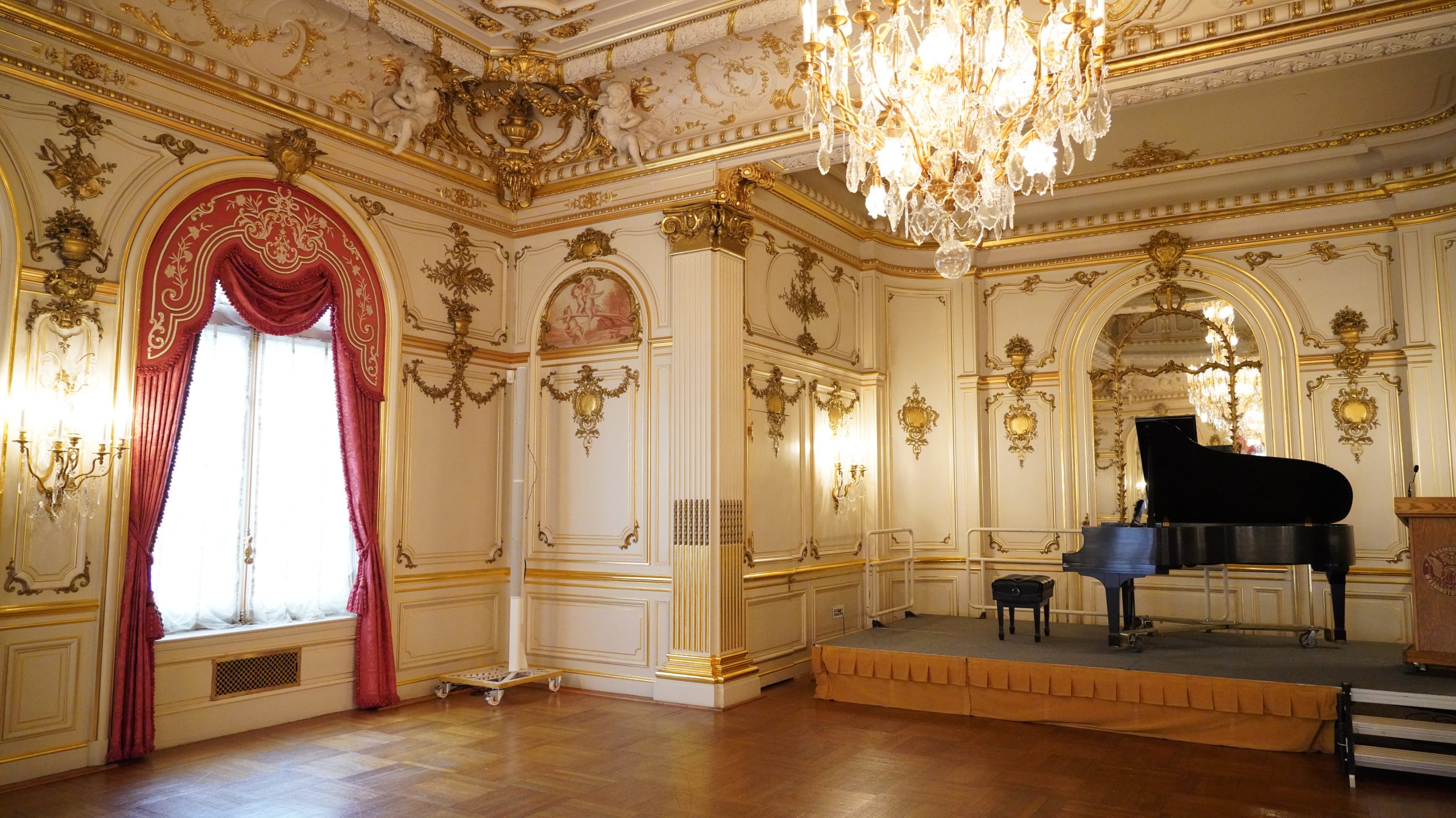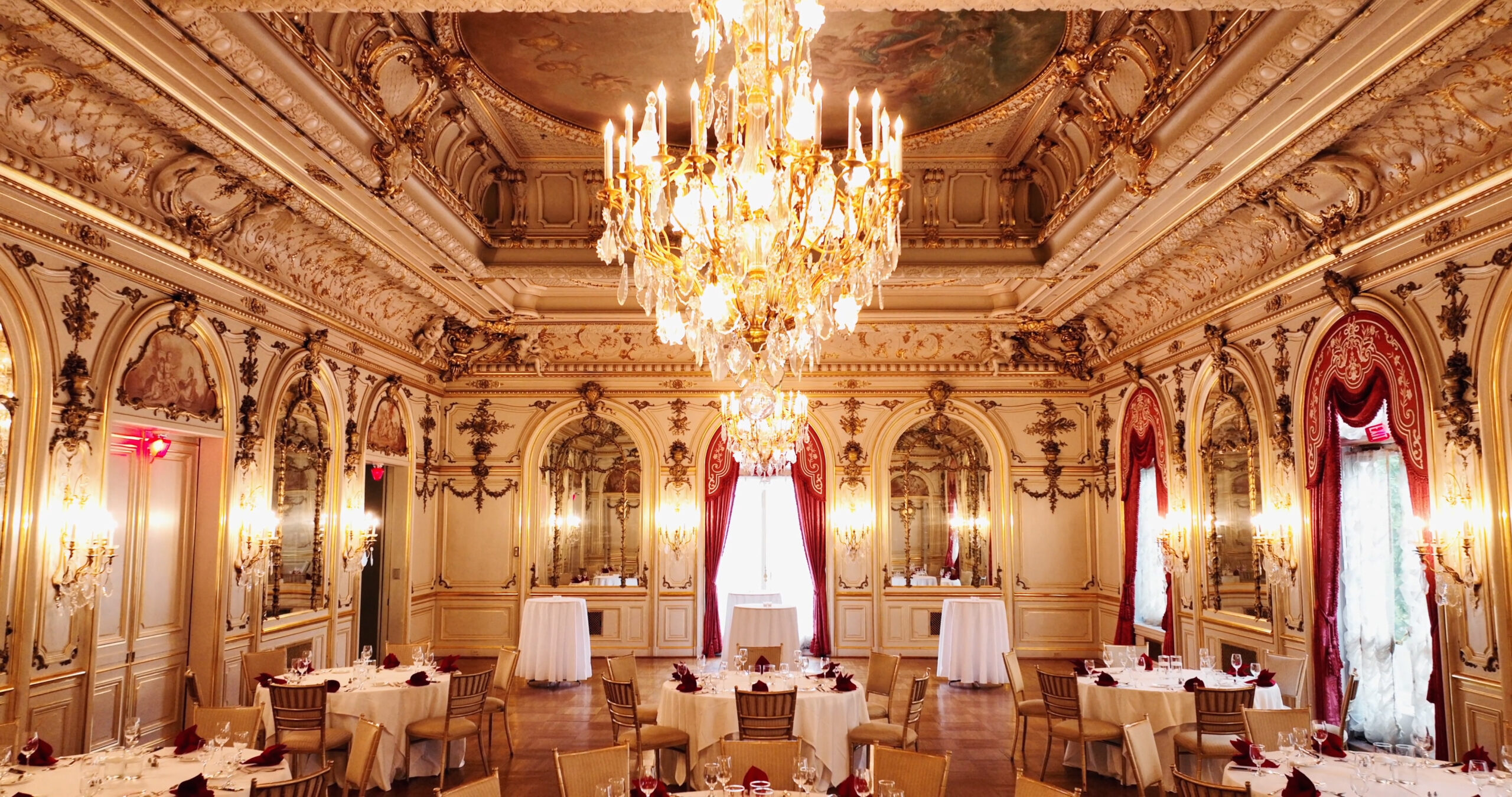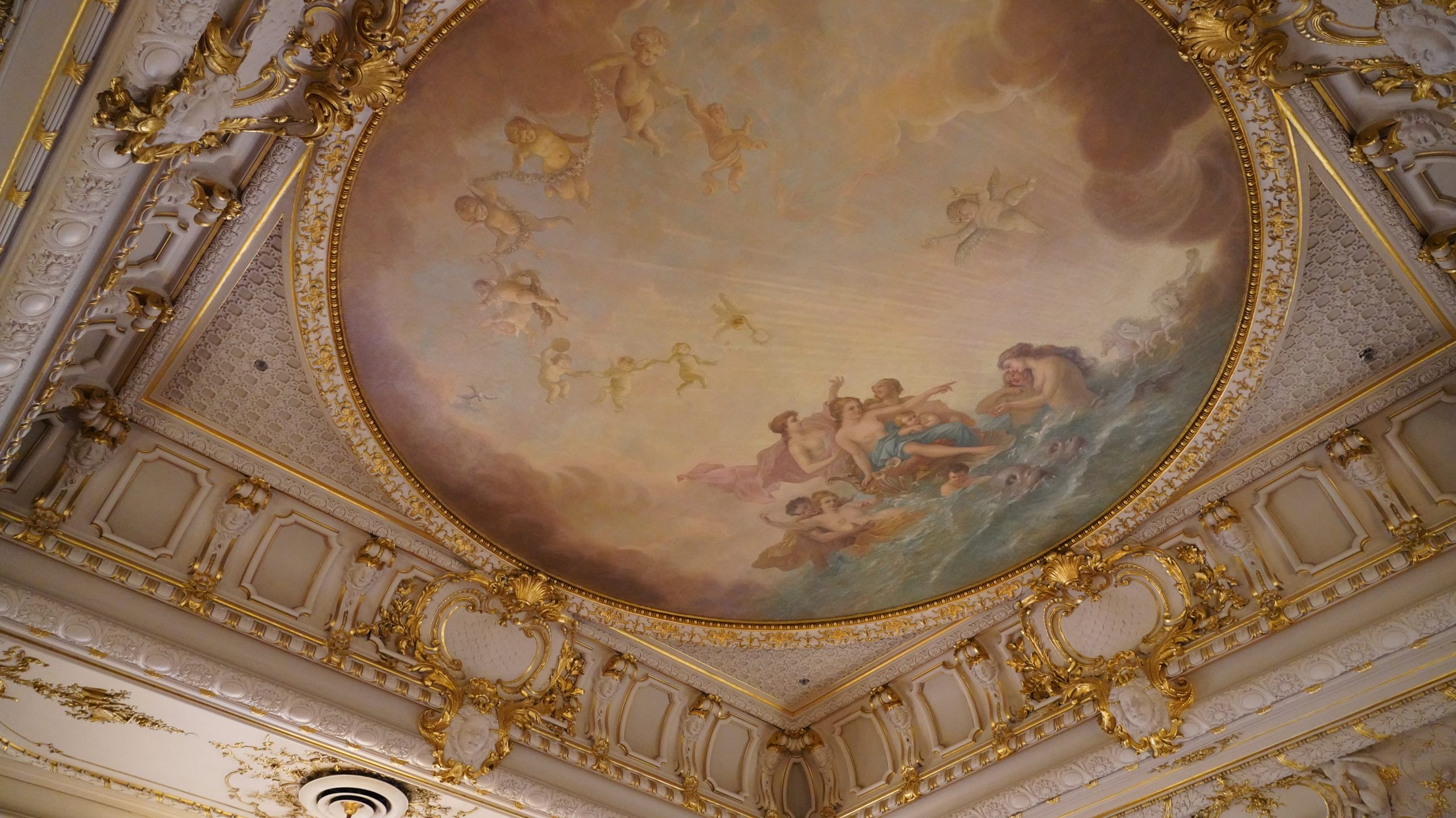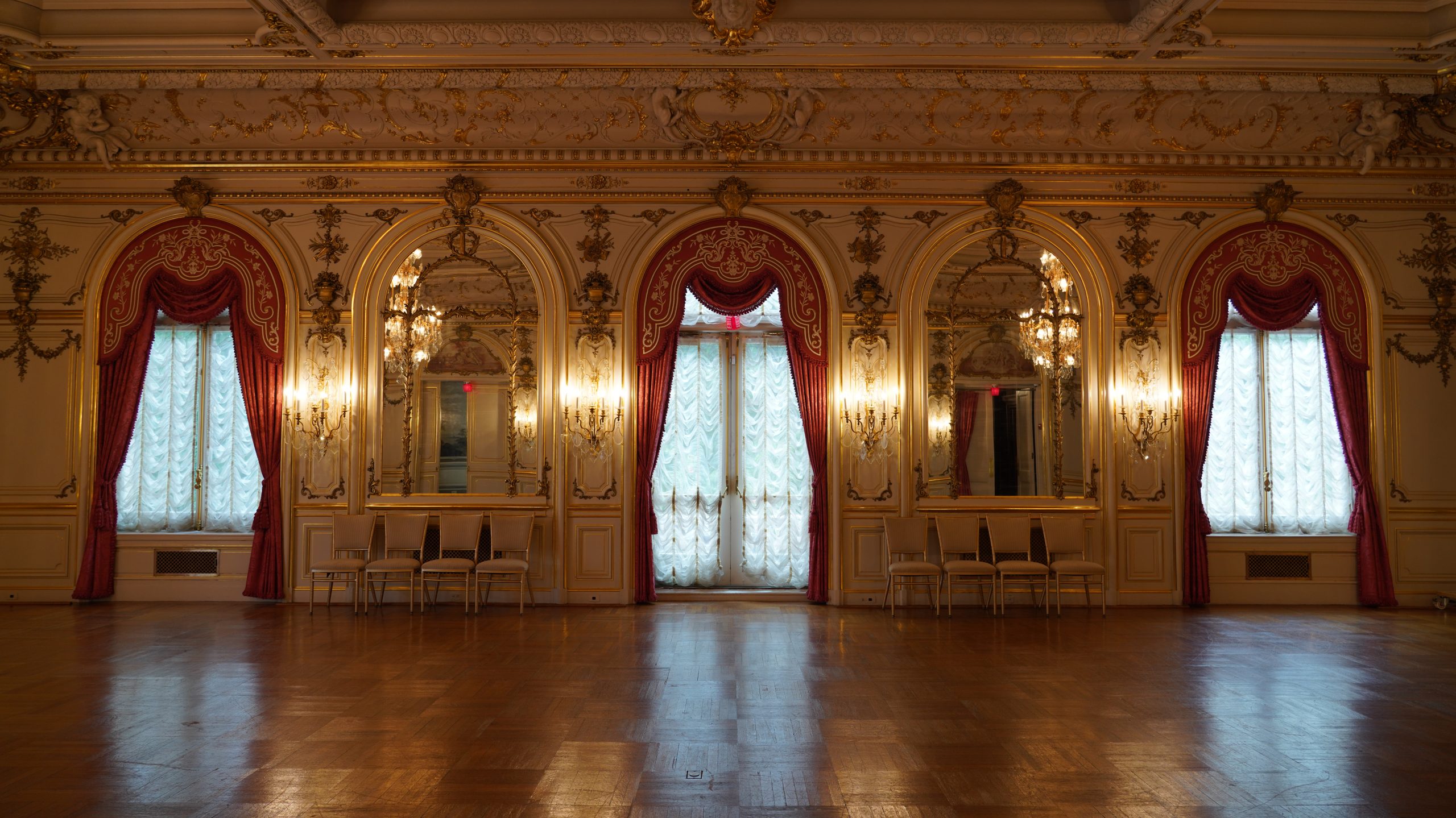
Warne Ballroom

Restoration of the Ballroom
By Andrea F. Schoenfeld
Published in Cosmos Bulletin, March 2012
It took 6,000 linear feet of gold, $2 million, eight and a half months of work, and six years of planning to restore the Warne Ballroom to its former glory as one of Washington’s finest Gilded Age salons.
The inspiration for the ballroom was the mid-18th century France of Louis XV. The architects of the Townsend Mansion, built at the turn of the 20th century, were John Merven Carrère and Thomas Hastings, trained at the Ecole des Beaux Arts in Paris. The interior designer, responsible both for the architectural detail and the furnishings, was the renowned Parisian firm, Jules Allard & Fils, with offices in London and New York. Allard collected architectural salvage from chateaux and 18th century townhouses. Allard’s Paris workrooms produced woodwork, cabinetry and chairs, marquetry, paneling, bronze, and other metalwork for an international clientele, including the Rothschilds in London and the Vanderbilts in New York and Newport. Mrs. Richard Townsend, who sometimes summered in Newport, may have been familiar with the Allard interiors at The Breakers and Marble House. At the time Allard designed the Townsend interiors, the firm also installed the interiors of The Elms and Rosecliff.
No Townsend family documentation on the construction of the house survives. In 2003 the Cosmos Club Historic Preservation Foundation learned through Paul Miller (’07), curator of the Preservation Society of Newport County, that Allard had designed the Townsend interiors. This discovery enhanced the Club’s appreciation of the ballroom and the importance of restoring each element to its original appearance in order to achieve the dramatic effect of the design as a whole.
The Foundation, which funded the restoration of the historic plaster, woodwork, painting, gilding, original lighting and floor, decided to restore the ballroom to its appearance in the period 1901-15. These dates were chosen because the only surviving historic photographs of the Townsend Mansion interior are those published in the Architectural Record in 1901 and Frances Benjamin Johnston’s photographs circa 1915. They document alterations in the decoration of some rooms. The 1901 photograph of the ballroom shows globe-shaped light fixtures suspended from each of the three sections of the ceiling. By 1915 they had been replaced by large chandeliers in the north and south coves and a mural in the central section. The wall sconces also were installed after 1901.
Planning for the restoration began in earnest in 2006 when the Foundation commissioned Mr. Miller to develop a restoration plan, and he provided informal guidance throughout the project. John Milner Associates, Inc., of Alexandria, Virginia was selected to prepare a detailed rehabilitation/restoration master plan including the updating of heating, air-conditioning, lighting and audio-visual systems. The Foundation received permission from the Internal Revenue Service to spend tax-deductible donations on interior renovations in 2009.


The ballroom closed for renovations on June 15, 2011. Whiting-Turner Contracting Co., which had extensive experience working in the Clubhouse, was selected as the general contractor, and Matthew Whalen as the owner’s representative. John Canning & Co., Ltd., of Cheshire, Connecticut, which has worked on the White House and Capitol, and the Executive Office, Treasury, and Pension buildings, was chosen to restore the historic fabric. David Riccio was Canning’s project manager for the ballroom. The firm brought in a staff of 18 from around the country and also used two local subcontractors: Page Conservation, Inc., which did the painting restoration, and Gold Leaf Studios, which did the water gilding. At times there were as many as 15 to 17 people working in the room, using nine rolling scaffolds.
Richard C. Wolbers, a professor in Winterthur/University of Delaware master’s-level program in art conservation, tested 40 samples to determine the original paint and gilding materials used in the ballroom. Scientific analysis of the initial paint layers—hidden under 15 to 20 coats of paint on the walls—revealed that the original color was a light warm gray known as “French Gray.” The walls and ceiling are both painted in the same gray tone and the contrast between them is achieved through texture. The walls have a velvety sheen while the ceiling paint is flat. Achieving the soft, smooth enamel finish required many hours of hand sanding before and between coats to eliminate old brush strokes and coats of acrylic paint. On the ceiling, the recessed portions of the diapering around the mural were painted a slightly darker tone of gray to add depth.
For the applied ornament, Allard used a plaster compound that was faster and less expensive to install than traditional carved wood boiserie. Roof leaks and condensation around the air diffusers had caused extensive damage to both ornamental and flat plaster, particularly in the northwest corner of the room and the north coffer of the ceiling. Some could be consolidated and some had to be replaced. Canning cast molds of the ornamentation from sound areas to recreate the plasterwork in damaged areas.
The true nature of the ballroom’s gilding was obscured by years of coats of bronze paint. Much of the bronze paint used on the wall decorations could be cleaned off with solvents but the bronze paint applied to the ceiling cove could not be removed without destroying the original finish underneath. Thus, while it was possible to restore much of the oil-gilded wall decoration, most of the ceiling decoration had to be gilded anew. The chair rail, designed to create a bright unifying band around the room, was badly worn and so was regilded over a coating that preserved what remained of the original finish.
The parquet floor’s old finish was stripped with a citrus compound. Then four coats of tung oil were applied to restore its sheen and protect it from wear.
Delve Deeper.
Interested in learning more? Click on the links below to see more on the Warne Ballroom restoration….
Warne Ballroom Restoration Video
Warne Ballroom Restoration Project Receives Award
Warne Ballroom Restoration Stories – Cosmos Bulletin March 2012